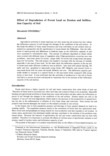Effect of Degradation of Forest Land on Erosion and Infiltration Capacity of Soil
JIRCAS international symposium series
| ISSN | 13406108 |
|---|---|
| 書誌レコードID(総合目録DB) | AA1100908X |

本文フルテキスト
intlsymp-1_55-63.pdf251.66 KB
Agricultural activities in forest land may not only cause top soil erosion but also reduce the infiltration capacity of soil through the changes of the conditions of the soil surface. In this study the effects of forest stand formation and crop cultivation on soil erosion were examined in a prospective site for agroforestry in Luzon island, the Philippines. Also the influences of stand growth and differences in land-use types on the infiltration capacity of soil were examined in reforestation sites. The amount of sediment deposited on slopes which were covered with different types of vegetation after 170mm precipitation occurring once was as follows : bare land, about 2.8 ton/ha ; ginger field, 2.0 ton/ha and young forest and grassland, 0.3~0.8 ton/ha. The soil erosion rate tended to increase with the increase of rainfall, especially in the case of bare land. On the other hand, the infiltration capacity of the top soil in forest land under different conditions was as follows: bare land with annual burning, 100mm/hr and less; grassland or man-made young forest, 200~500mm/hr, and natural forest or man-made forest with ten years old stands, 500mm/hr and over. The infiltration capacity generally tended to increase in a natural forest or old man-made forest compared with young forest or bare land. It was confirmed that the activities of earthworms in the soil of forest land led to a porous structure and played an important role in the increase of the infiltration capacity of the soil surface.
| 作成者 | Hiromichi ONODERA |
|---|---|
| 公開者 | Japan International Research Center for Agricultural Sciences |
| オンライン掲載日 | |
| 号 | 1 |
| 開始ページ | 55 |
| 終了ページ | 63 |
| 言語 | eng |
